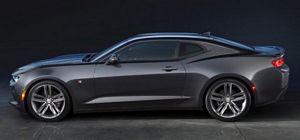|
By accessing or using The Crittenden Automotive Library™/CarsAndRacingStuff.com, you signify your agreement with the Terms of Use on our Legal Information page. Our Privacy Policy is also available there. |

2016 Turbo Camaro Could Be Far Lighter than EcoBoost Mustang
|
|---|
|
|
2016 Turbo Camaro Could Be Far Lighter than EcoBoost Mustang
Patrick Rall, TorqueNews
July 9, 2015 (13:08)
We still don’t have the official weight figures for the 2016 Chevrolet Camaro, but based on comments made by Camaro mastermind Al Oppenheiser when speaking with Autoblog, it sounds as though the turbocharged 4-cylinder Chevy muscle car could weigh significantly less than the popular EcoBoost Mustang – which could help make up for the power differential between the two.
When the 2016 Chevrolet Camaro was introduced with a new 2.0L turbocharged 4-cylinder, I wasn’t all that surprised, as that same engine does a great job of powering the similarly-sized Cadillac ATS coupe. However, I was a bit surprised when it was announced that the turbo Camaro “only” has 275 horsepower and 295lb-ft of torque, making it less powerful than the 3.6L V6 and serving as the base model engine where the Mustang EcoBoost engine is the midlevel mill.
Based strictly on power numbers, the turbocharged 4-cylinder 2016 Camaro will have a tough time competing with the EcoBoost Mustang that offers 310 horsepower and 320lb-ft of torque. It was speculated that the turbo Camaro could be a little lighter than the EcoBoost Mustang, but based on comments made by GM’s Al Oppenheiser while speaking with Autoblog, the turbo Camaro could be much lighter than the turbo Mustang.
V6 Camaro, 300lbs Less
The folks at Autoblog posted an interview with Al Oppenheiser yesterday (that you can read
by clicking here) that included a wealth of information on the next generation Chevrolet Camaro. Oppenheiser talked at length about the new turbocharged 4-cylinder and how it performs in the 2016 Camaro, but towards the end of the interview, he made what I consider to be the most important information in the piece.
Oppenheiser stated that while the company has been saying that the 2016 Camaro is at least 200lbs lighter than the 2015 models, that information pertains specifically to the new Camaro SS. In V6 form, the 2016 Camaro is 300lbs lighter than the 2015 models and according to Oppenheiser, the 4-cylinder “feels lighter”. That doesn’t mean that it is lighter, but there is a good chance that the smaller 4-cylinder engine could weigh in the same range as the V6.
Based on the figures on the Chevrolet website, the 2015 Camaro V6 weighs 3,702lbs with the automatic transmission. If the 2016 Camaro V6 weighs 300lbs less than that, the 6th gen V6 Camaro would have a curb weight around 3,402lbs. Now, assuming that the GM weight loss numbers are fairly safe, we can guess that the actual weight loss level would be greater than 300lbs. If that real world number is 310lbs, for example, then the 2016 Camaro V6 would have a curb weight under 3,400lbs and if the turbo Camaro is lighter than the V6 models, they could also be just under 3,400lbs.
EcoBoost Mustang, Turbo Camaro- Power to Weight Ratio
Let’s assume for the sake of discussion that the 2016 Chevrolet Camaro with the turbocharged 4-cylinder engine weighs exactly 3,400lbs. The 2015 Ford Mustang EcoBoost weighs 3,532lbs, giving the Camaro an advantage of around 130lbs, but the Mustang still has a big advantage in horsepower and torque. To see how the competition will really play out, we have to look at power to weight ratios.
The 2016 Camaro turbocharged 4-cylinder weighing 3,400lbs will have a horsepower to weight ratio of 12.364lbs per horsepower and a torque to weight ratio of 11.53lbs per foot-pound of torque.
The 2015 Mustang EcoBoost has power to weight ratios of 11.39lbs per horsepower and 11.04lbs per foot-pound of torque
Based on these numbers, the Mustang EcoBoost should be a touch quicker than the turbo Camaro in a straight line, but the lighter construction of the Camaro could make it the superior road-handling vehicle. Also, the smaller engine and lighter chassis should make the Camaro with the 2.0L turbo-4 the most fuel efficient muscle car on the market, especially with the 8-speed automatic transmission.
The 2016 Chevrolet Camaro is expected to arrive this fall, so it shouldn’t be too much longer before we get the full specs on the 6th gen Camaro.
Source:
http://www.torquenews.com/106/2016-turbo-camaro-could-be-far-lighter-ecoboost-mustang



















